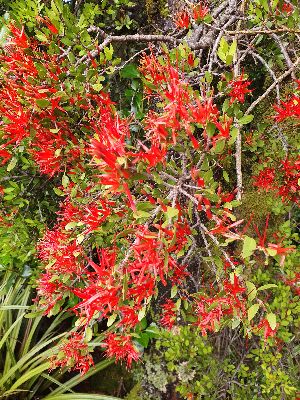Rare Native Mistletoe Population Discovered In The Eastern Bay Of Plenty
Mummy didn’t get caught kissing Santa Claus but threatened native mistletoe has been discovered in a corner of the Eastern Bay of Plenty where it has not previously been recorded.
NZ’s three beech mistletoe species are semi-parasitic plants which host on native beech trees or tawheowheo. They are best known for their brilliant displays of red flowers in summer.

All are considered under threat largely a result of sustained browsing by possums and the loss of native bird species which pollinate them.
Department of Conservation botanist Paul Cashmore said finding red mistletoe (Peraxilla tetrapetala) on the remote Motu Rd was a pleasant, if not totally unexpected, surprise when Rotorua Botanical Society members first discovered a plant in late 2019.
There had been no recorded sightings of any of the parasitic beech mistletoes in areas adjoining Motu Rd until this one large red mistletoe plant was seen overhanging the road on the northern side of Pāpāmoa Hill.
It was agreed that further survey should be undertaken along rest of the Motu Rd in December and January when plants were flowering but it took until 2022 for it to happen.
Mr Cashmore said the first task was to relocate the initial plant found in 2019 and record its details including how healthy it was.
After that, further plants were found either by looking for mature host tawheowheo trees and inspecting them with binoculars or by walking along the road looking for dropped red petals.
If red mistletoe plants were spotted, the tawheowheo trees were marked and the mistletoe plants’ health was assessed.
Mr Cashmore took two days to survey the entire length of Motu Rd from Meremere Hill Scenic Reserve to Motu township and found 25 red mistletoe plants, most of which were flowering, on 21 tawheowheo host trees.
“Finding 25 red mistletoe plants on tawheowheo is a significant discovery as there are no known or historic red mistletoe records in the immediate area along Motu Rd.
“The nearest plants present would be those in Otamatuna to the west or Moanui and Matawai to the south.”
“Twenty-three out of 25 red mistletoe plants - that’s 92% - showed evidence of dieback which generally recognises the past seasons’ browsing intensity by possums. This shows that plants are under regular possum browsing pressure to some extent with only two plants free of dieback.”
Mr Cashmore says the survey has demonstrated for the first time that not only is red mistletoe still present in and around the Motu-Urutawa forest, but that viable populations still exist in several places.
“It is important that these remnant populations are prevented from declining to extinction so, at very least, fur trapping needs to be encouraged in these areas.
“But ultimately this provides further justification for larger scale landscape pest control across this wider forest tract.”
There is good evidence from elsewhere that large scale possum control operations will result in a relatively quick recovery of mistletoe health and recruitment if sufficient residual plants are still present in a block.
Control of predators also contributes to mistletoe recovery through protection of bellbirds and tui which are its main pollinators.
About Mistletoe
Beech mistletoe populations have drastically declined throughout NZ, especially in the North Island, with only remnant populations in isolated areas.
In the Bay of Plenty significant populations are found in Whirinaki Te Pua-a-Tāne Conservation Park and parts of Te Urewera.


 Gordon Campbell: On Why We Can’t Survive Two More Years Of This
Gordon Campbell: On Why We Can’t Survive Two More Years Of This NZ Government: Drive Safely This Summer
NZ Government: Drive Safely This Summer Northland Inc: Game-Changing Investment For Northland - Resilience Fund Allocates $250,000 To Health Simulation & Training Centre
Northland Inc: Game-Changing Investment For Northland - Resilience Fund Allocates $250,000 To Health Simulation & Training Centre Interchurch Bioethics Council: Church Bioethics Agencies Express Dismay at the Rushed Consultation Period for Submissions on the Gene Technology Bill
Interchurch Bioethics Council: Church Bioethics Agencies Express Dismay at the Rushed Consultation Period for Submissions on the Gene Technology Bill New Zealand Police: More Than $2.5m Worth Of Assets Restrained In Undeclared Tobacco Case
New Zealand Police: More Than $2.5m Worth Of Assets Restrained In Undeclared Tobacco Case SPCA: Survey Shows Government Lacks Mandate To Repeal Live Export Ban
SPCA: Survey Shows Government Lacks Mandate To Repeal Live Export Ban Peace Action Ōtautahi: Bridge Of Remembrance Peace Protest
Peace Action Ōtautahi: Bridge Of Remembrance Peace Protest


